The great thing about hot rodding is that it can take many forms. From show winning customs to 200+mph race cars, the spectrum is almost infinite. One of the most exciting, and definitely the fastest, are the hot rods that are chasing land speed records. Sanctioned by the Southern California Timing Association, participants can compete for speed records in a seemingly infinite number of classes. If you want to go fast and maybe put your name in the record books, then this 1932 Ford Model B powered racer for sale on craigslist in sunny Phoenix, Arizona may be the ride for you. Evidently the seller is so focused on their next project that they forgot to post a price in the ad. I guess if you have to ask… Thanks to T.J. for the interesting find!
Is building a land speed record car a form of hot rodding? Ask the folks at the Southern California Timing Association. This group has been around since 1937, making them the oldest racing organization in the United States. Basically, this non-profit is a gathering of multiple car clubs with the express purpose of organizing and recording land speed record runs under a set of mutually agreed on rules. One of the neat things you can do is go to the American Hot Rod Foundation’s Rodcast web page and listen to first person accounts from the hot rodders that raced on the salt before and after the war. They also have some great stories of running from the police in these fast for the era hot rods.
This year’s event was to be held this week (August 6-12). Sadly, this article by The Drive tells us that the event is cancelled this year due to heavy rains. This might explain why this particular car was posted about a week ago. Maybe they just knew the weather wasn’t going to cooperate. Or, the seller simply got tired of turning his big savings account into a small one.
Reading through the laundry list of name brand speed parts on this car you can see just how expensive this project has been. It is powered by a Model B Ford engine with a Cyclone/Cook overhead cam conversion on the top end. The crankshaft is originally from a fairly rare Model C engine, and it has been counterbalanced. The domed Arias pistons are connected to the crank with Crowder billet rods. The flywheel is steel and is from the famous racing parts outfit Meyer-Drake, but it is not said if this is a vintage part or a modern reproduction. The big block Chevy valves and springs are pushed by a Dema Elgin cam. Spark is provided by a Bosch Magneto.
The picture above shows a very clever shock and spring system for the pivoting rear section. Hopefully readers can give us a good description on why this is a better system than having a completely rigid frame. My guess is that some form of harmonics come into play at high speeds that cause the frame to flex, and this setup helps to dampen that.
Of course, the dash of this land speed record car has no speedometer. My guess is that the driver knows basically how fast the car is going at set RPM points. While I doubt that you could make a speedometer read accurately at speed, it still would be nice to have as another data point. The dash does have an rpm gauge, an oil pressure gauge, and a water temperature gauge. We also see two pull outs for fire and an assortment of switches to handle the electrical needs of the car. I am unaware as to what the two levers with black knobs are for. Perhaps parachutes?
At the driver’s feet is the standard accelerator, brake, and clutch pedal assembly. This one however appears to be fashioned from aluminum. The braided lines are a bit puzzling. Are these brake lines or fuel lines? It looks like they are routed off the master cylinder, but why do they terminate at the floorboard?
The engine looks quite modern for a design that reached production in 1932. One of the more interesting features is that it comes with two different fuel set ups. The ad states that it is set up for fuel with three Stromberg 48 carburetors. If you want to set it up for gas, there is a manifold with two Stromberg 98s attached. My assumption is that fuel means some type of nitro or alcohol mix, and that gas is for gasoline. Once again, I am hoping for experienced readers to fill in the blanks here.
In the picture above we see some of the more interesting design elements of the car. We get another shot at the pivoting rear frame and the Model B engine. We can also see a small fuel tank and a large aluminum radiator. The location and size of the radiator is puzzling to me. Does this car generate that much heat over a run? If so, would there be a more aerodynamic place to locate the radiator given that aerodynamics is so crucial to a good run?
The seller tells us that there are many more features, and that interested buyers should make contact if they want more information. We are also told that there is a SCTA logbook for the car, and a picture is provided of it in the ad and above. Given the limited market for such a vehicle it is a little surprising that it is listed on craigslist, but sometimes all a starry-eyed dreamer needs is a little push to make a big expenditure.
Have you ever dreamed of running the salt flats?
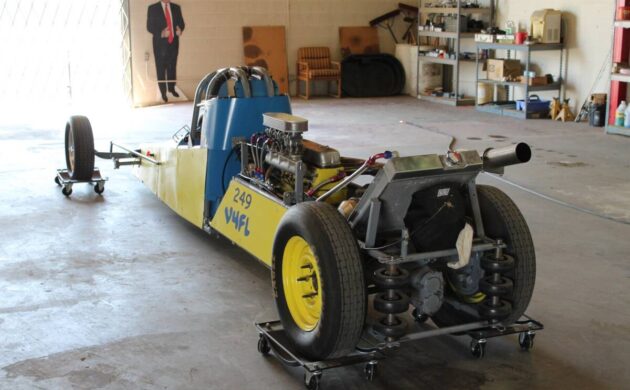
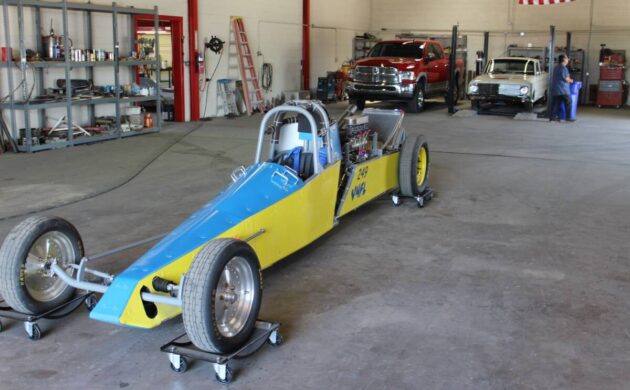

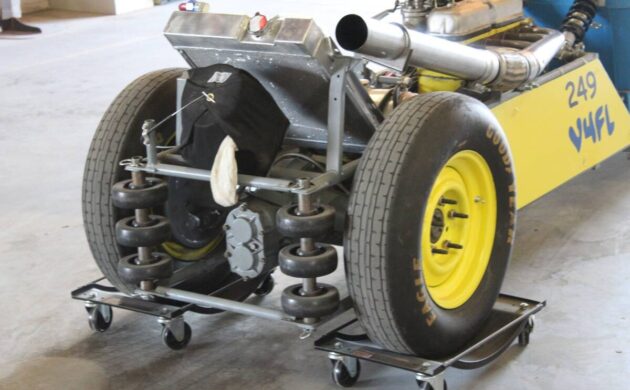


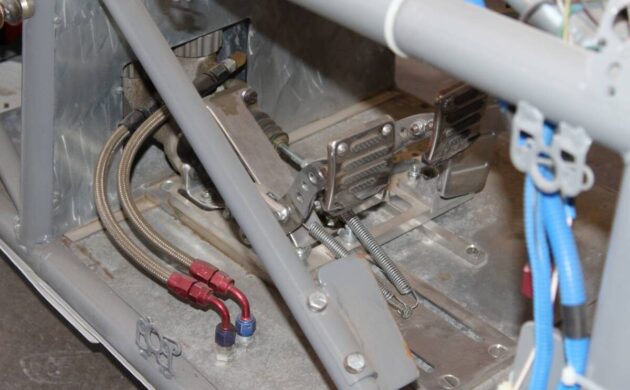
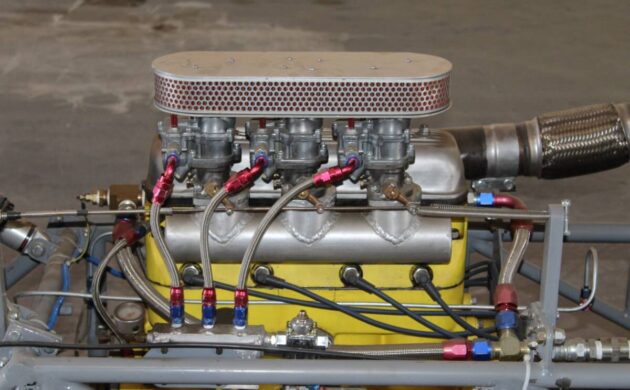
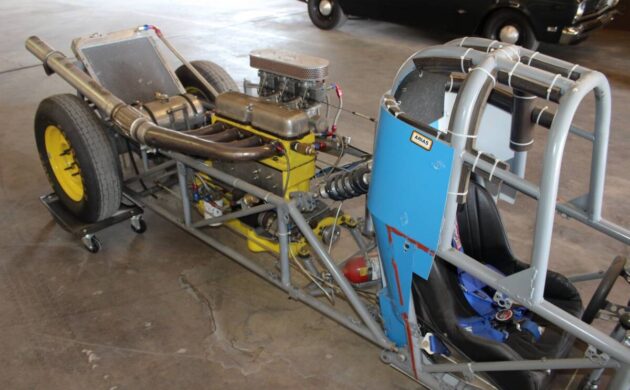
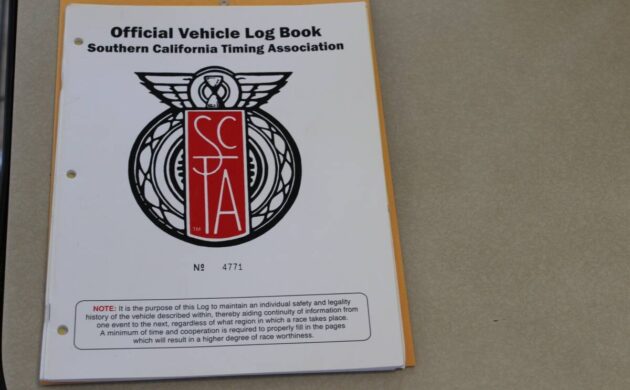


No Speed Week pros out there? Looking to learn something.
It’s a cubic inch class and yes the OHV conversion was available before WWII and used on the dry lakes before Bonnyville racing started – so yes its a modified block for that class and which is different than the Model A block before it. Maybe just for bragging rights BUT still a OEM block.
If there’s a coolant leak, you want it behind you rather than in front of you.
I wonder if they figured there’d be a slipstream effect that would suck hot air behind the car.
How can you call this a 1932 Ford B Salt Flat racer if the only part they used a was 1932 Ford block. Heck, they then Frankenstein it even further by using Chevy valves, non-Ford cam and magneto? Did the builder call it a 1932 Ford racer; or the writer of this article?
Oh wait, if I shoved a 2022 Lamborghini Aventador 6.5 lt V-12 engine into the racer we could then call it a 2022 Lamborghini Salt Flat racer.
If you had gotten beyond the title and the first picture, you would have read that it is a ‘32 Ford Model B powered race car, powered being the key word. Yes the title was a bit misleading…
Your lack of knowledge shows……
To me, NOT aerodynamic enough for the Flats, this was likely a drag rail racer. And there were no aluminum radiators, OR A&N hoses & fittings back then in 32. But a neat old racer. just saying.
This setup is probably good for about 110-130 MPH so don’t think aerodynamics is a huge factor. Don’t think anybody said or implied that this was built in the thirties, just that the motor is from the thirties. There are classes for Model A / B powered vehicles, some of the classes permit radical modification with the primary requirement that the block is an actual Model A / B block.
The designation is “V4FL”, so vintage 4 cylinder fuel lakester. Looks like the record in that class is 118.328 mph.
Not a pro, but I do hold a USFRA 130 club standing, so I know a little about these things.
As you guessed, the shock/spring mechanism is probably to try to handle variations in the track surface. The track is graded to make it as flat as possible, but at 200/300mph, any variation is a big deal. If the nose lifts, air flow tends to make the whole car just fly up then crash. Not a good scenario.
As far as the different carbs/manifolds go, there are different fuel classes (e.g. vintage fuel and modern gas) beyond the different engine classes. Looks like they’ve got it set up for both modern fuel and an old vintage fuel type.
Not sure about those threaded lines going to the floor.
BTW, the link provide goes to an F350 truck, not this car, for some reason.
Racers at Bonneville compete in specific classes. The chassis makes this a “streamliner,” and the engine places it in a specific (and probably rarely contested) Model A/B/C class. Furthermore, the ability to run two different fuels (gasoline, and ‘furl’ which is top fuel as used by dragsters) means the racer could compete for and potentially hold speed records in multiple categories simply by changing carbs.
I have been to Boniville a few times and if you get out on the salt you will see that the surface is far from smooth. You need an active suspension to keep from bouncing and loosing traction. This is a cool race car.
I work on the Blacksalt LSR car. A couple years ago a U haul short box truck rental type pitted close to us. I saw a 2 piece vehicle come down the ramp, made to fit a short truck !! This may be that car. It bolted together in the middle, you see lots of strange things there !